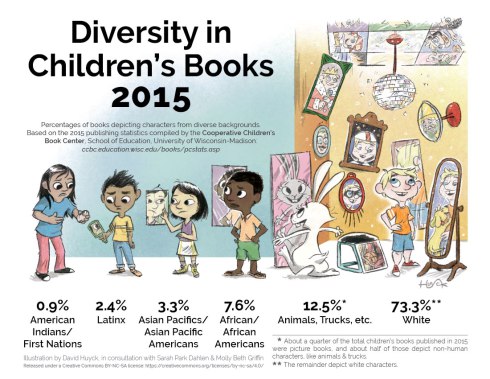Middle School Monday: Professional Development. Not the Optional Kind.
A Crucial Strand of PD.
We have an early-release day coming up. Does your school have those? Where you get to squeeze the work of a whole school day with students into a shorter time frame and then stay for meetings and/or professional development? Just typing that out is making me a bit tired.
This year, our staff is breaking up into small groups to work together on a professional development ‘strand’ of our choice. Two of our ELA teachers asked me to lead a strand on diverse literature. How awesome is that?
ADVERTISEMENT
ADVERTISEMENT
I eagerly said yes. Not only is it a favorite subject—and my guiding framework for collection development—but, we all need to be engaging in PD on this topic. We all need to continually be learning more. Thus, our REFLECTIVE LITERATURE PD strand was born. In addition to our ELA teachers from each grade, we also count our Assistant Principal and one of our Social Studies teachers as members.
Of course, the need for reflective literature is part of a larger conversation. When we talk about having books in our schools that reflect our students, their lived experiences, and their interests, it’s necessary to situate that idea in a discussion on culturally relevant pedagogy, structural inequities, institutional racism, and white privilege.
As we engage in these discussions with school staff, it’s helpful to remember that we are all at different points on our own cultural competence journeys. I thought I’d share our four point plan for our first meeting as these are resources or ideas that you might enjoy for yourself or want to share.
One. The Danger of a Single Story.
In Chimamanda Adichie’s illuminating TED Talk, The Danger of a Single Story, she shares her own first experiences with reading to drive home the point how “impressionable and vulnerable we are in the face of a story, particularly as children.” She brings together insights on reading, writing, power, stereotypes and story. And the joy of reading books that reflect you. Even if you’ve seen this before, each time is a gift for us as viewers—new understandings, powerful ideas, and favorite quotes. It made an ideal kick-off to our discussion.
Two. Diversity in Children’s Books 2015 Infographic.
The CCBC infographic below—Diversity in Children’s Books 2015—appeared on Sarah Park Dahlen’s post, Picture This: Follow Up. [The powerful imagery draws on the Windows/Mirrors analogy for literature first written by Rudine Sims Bishop. If you’ve never read her original article, find it here.]
This infographic is talking strictly about QUANTITY. Debbie Reese’s post at A Close Look at CCBC’s 2015 Data breaks down the 0.9% for American Indians/First Nations even further—taking into account reviews and authors. It is a crucial complement to the raw publishing data.
We didn’t start with these numbers to depress us, but rather to galvanize us.
Three. Race: The Power of an Illusion.
After a quick walk-through of PBS’s informative site, Race: The Power of an Illusion, we broke apart to engage with the site on our own.
Four. #ownvoices.
We then talked about the importance and necessity of #ownvoices titles. I had curated a stack of novels from our library collection and gave EXTREMELY quick booktalks on the titles. We each then chose one to read for our next PD strand meeting. Below are some of the titles chosen.
I’m Julie Stivers at @BespokeLib and I get excited talking about reflective literature!
Filed under: Middle School Monday
About Robin Willis
After working in middle school libraries for over 20 years, Robin Willis now works in a public library system in Maryland.
ADVERTISEMENT
ADVERTISEMENT
SLJ Blog Network
2024 Books from Pura Belpré Winners
In Memorium: The Great Étienne Delessert Passes Away
Winnie-The-Pooh | Review
Parsing Religion in Public Schools
ADVERTISEMENT









